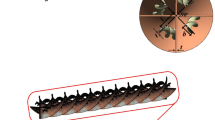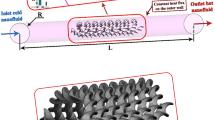Abstract
The focus of the current investigation is on insertion of complex-shaped device for inducing swirl intensity. H2O-based copper oxide mixture was assumed as testing fluid with considering empirical formulation for estimation of properties. Different contours of outputs were extracted via FVM. Insertion of helical device results in repeated counterclockwise and clockwise movement of nanomaterial within the pipe which helps the convective mode. Using lager width of helical inserts makes the temperature gradient to augment and results in grater secondary flow. As inlet velocity augments with rise of pumping power, more interaction of nanomaterial with solid surfaces generates higher turbulent intensity.















Similar content being viewed by others
References
Yang L, Du K. A comprehensive review on the natural, forced and mixed convection of non-Newtonian fluids (nanofluids) inside different cavities. J Therm Anal Calorim. 2019. https://doi.org/10.1007/s10973-019-08987-y(in press).
Sheikholeslami M. New computational approach for exergy and entropy analysis of nanofluid under the impact of Lorentz force through a porous media. Comput Methods Appl Mech Eng. 2019;344:319–33.
Szilágyi IM, Kállay-Menyhárd A, Šulcová P, Kristóf J, Pielichowski K, Šimon P. Recent advances in thermal analysis and calorimetry presented at the 1st Journal of Thermal Analysis and Calorimetry Conference and 6th V4 (Joint Czech-Hungarian-Polish-Slovakian) thermoanalytical conference (2017). J Therm Anal Calorim 2018; 133:1–4.
Sheikholeslami M, Rezaeianjouybari B, Darzi M, Shafee A, Li Z, Nguyen TK. Application of nano-refrigerant for boiling heat transfer enhancement employing an experimental study. Int J Heat Mass Transf. 2019;141:974–80.
Tang G, Shafee A, Nam ND, Tlili I. Coulomb forces impacts on nanomaterial transportation within porous tank with lid walls. J Therm Anal Calorim. 2020. https://doi.org/10.1007/s10973-020-09407-2.
Sheikholeslami M, Jafaryar M, Shafee A, Li Z, Haq R. Heat transfer of nanoparticles employing innovative turbulator considering entropy generation. Int J Heat Mass Transf. 2019;136:1233–40.
Yang L, Mao M, Huang JN, Ji W. Enhancing the thermal conductivity of SAE 50 engine oil by adding zinc oxide nano-powder: an experimental study. Powder Technol. 2019;356:335–41.
Li Y, Shakeriaski F, Barzinjy AA, Dara RN, Shafee A, Tlili I. Nanomaterial thermal treatment along a permeable cylinder. J Therm Anal Calorim. 2019. https://doi.org/10.1007/s10973-019-08706-7.
Rezaeianjouybari B, Osgouie KG, Meghdari A. Employing neural networks for manipulability optimization of the dual-arm cam-lock robot. In: ASME international mechanical engineering congress and exposition, proceedings (IMECE), vol. 8; 2010.
Shafee A, Jafaryar M, Abohamzeh E, Nam ND, Tlili I. Simulation of thermal behavior of hybrid nanomaterial in a tube improved with turbulator. J Therm Anal Calorim. 2020. https://doi.org/10.1007/s10973-019-09247-9.
Sheikholeslami M, Shehzad SA, Li Z, Shafee A. Numerical modeling for alumina nanofluid magnetohydrodynamic convective heat transfer in a permeable medium using Darcy law. Int J Heat Mass Transf. 2018;127:614–22.
Manh TD, Nam ND, Abdulrahman GK, Moradi R, Babazadeh H. Impact of MHD on hybrid nanomaterial free convective flow within a permeable region. J Therm Anal Calorim. 2019. https://doi.org/10.1007/s10973-019-09008-8.
Xiong Q, Ayani M, Barzinjy AA, Dara RN, Shafee A, Nguyen-Thoi T. Modeling of heat transfer augmentation due to complex-shaped turbulator using nanofluid. Phys A. 2020;540:122465.
Qin Y, He H, Ou X, Bao T. Experimental study on darkening water-rich mud tailings for accelerating desiccation. J Clean Prod. 2019. https://doi.org/10.1016/j.jclepro.2019.118235.
Sheikholeslami M, Sheremet MA, Shafee A, Li Z. CVFEM approach for EHD flow of nanofluid through porous medium within a wavy chamber under the impacts of radiation and moving walls. J Therm Anal Calorim. 2019. https://doi.org/10.1007/s10973-019-08235-3.
Qin Y, Hiller JE, Meng D. Linearity between pavement thermophysical properties and surface temperatures. J Mater Civ Eng. 2019. https://doi.org/10.1061/(ASCE)MT.1943-5533.0002890.
Manh TD, Nam ND, Abdulrahman GK, Shafee A, Shamlooei M, Babazadeh H, Jilani AK, Tlili I. Effect of radiative source term on the behavior of nanomaterial with considering Lorentz forces. J Therm Anal Calorim. 2019. https://doi.org/10.1007/s10973-019-09077-9.
Qin Y, Luo J, Chen Z, Mei G, Yan L-E. Measuring the albedo of limited-extent targets without the aid of known-albedo masks. Sol Energy. 2018;171:971–6.
Karimi-Maleh H, Arotiba OA. Simultaneous determination of cholesterol, ascorbic acid and uric acid as three essential biological compounds at a carbon paste electrode modified with copper oxide decorated reduced graphene oxide nanocomposite and ionic liquid. J Colloid Interface Sci. 2020;560:208–12.
Manh TD, Salehi F, Shafee A, Nam ND, Shakeriaski F, Babazadeh H, Vakkar A, Tlili I. Role of magnetic force on the transportation of nano powders including radiation. J Therm Anal Calorim. 2019. https://doi.org/10.1007/s10973-019-09182-9.
Shafee A, Sheikholeslami M, Jafaryar M, Babazadeh H. Utilizing copper oxide nanoparticles for expedition of solidification within a storage system. J Mol Liq. 2020;302:112371. https://doi.org/10.1016/j.molliq.2019.112371.
Qin Y. A review on the development of cool pavements to mitigate urban heat island effect. Renew Sustain Energy Rev. 2015;52:445–59.
Gao W, Zhu LL, Wang KY. Ranking based ontology scheming using eigenpair computation. J Intell Fuzzy Syst. 2016;31(4):2411–9.
Manh TD, Nam ND, Abdulrahman GK, Moradi R, Babazadeh H. The influence of Hybrid nanoparticles transportation on natural convection inside porous domain. Int J Mod Phys C. 2019;31:1–14.
Qin Y, He Y, Hiller JE, Mei G. A new water-retaining paver block for reducing runoff and cooling pavement. J Clean Prod. 2018;199:948–56.
Ahammed N, Asirvatham LG, Wongwises S. Thermoelectric cooling of electronic devices with nanofluid in a multiport minichannel heat exchanger. Exp Therm Fluid Sci. 2016;74:81–90.
Stogiannis IA, Mouza AA, Paras SV. Efficacy of SiO2 nanofluids in a miniature plate heat exchanger with undulated surface. Int J Therm Sci. 2015;92:230–8.
Ma X, Sheikholeslami M, Jafaryar M, Shafee A, Nguyen-Thoi T, Li Z. Solidification inside a clean energy storage unit utilizing phase change material with copper oxide nanoparticles. J Clean Prod. 2020;245:118888. https://doi.org/10.1016/j.jclepro.2019.118888.
Huang D, Wu Z, Sunden B. Effects of hybrid nanofluid mixture in plate heat exchangers. Exp Therm Fluid Sci. 2016;72:190–6.
Mukesh Kumar PC, Palanisamy K, Kumar J, Tamilarasan R, Sendhilnathan S. CFD analysis of heat transfer and pressure drop in helically coiled heat exchangers using Al2O3/water nanofluid. J Mech Sci Technol. 2015;29(2):697–705.
Sheikholeslami M, Mahian O. Enhancement of PCM solidification using inorganic nanoparticles and an external magnetic field with application in energy storage systems. J Clean Prod. 2019;215:963–77.
Qin Y, Zhao Y, Chen X, Wang L, Li F, Bao T. Moist curing increases the solar reflectance of concrete. Constr Build Mater. 2019;215:114–8.
Sheikholeslami M. Numerical approach for MHD Al2O3-water nanofluid transportation inside a permeable medium using innovative computer method. Comput Methods Appl Mech Eng. 2019;344:306–18.
Qin Y, Zhang M, Hiller JE. Theoretical and experimental studies on the daily accumulative heat gain from cool roofs. Energy. 2017;129:138–47.
Karimi-Maleh H, Shafieizadeh M, Taher MA, Opoku F, Kiarii EM, Govender PP, Ranjbari S, Rezapour M, Orooji Y. The role of magnetite/graphene oxide nano-composite as a high-efficiency adsorbent for removal of phenazopyridine residues from water samples, an experimental/theoretical investigation. J Mol Liq. 2019. https://doi.org/10.1016/j.molliq.2019.112040.
Gao W, Wang WF. Second atom-bond connectivity index of special chemical molecular structures. J Chem. 2014. https://doi.org/10.1155/2014/906254.
Qin Y, He H. A new simplified method for measuring the albedo of limited extent targets. Sol Energy. 2017;157(Supplement C):1047–55.
Sheikholeslami M. Numerical simulation for solidification in a LHTESS by means of nano-enhanced PCM. J Taiwan Inst Chem Eng. 2018;86:25–41.
Qin Y, He Y, Wu B, Ma S, Zhang X. Regulating top albedo and bottom emissivity of concrete roof tiles for reducing building heat gains. Energy Build. 2017;156(Supplement C):218–24.
Gao W, Wang WF. The vertex version of weighted wiener number for bicyclic molecular structures. Comput Math Methods Med. 2015. https://doi.org/10.1155/2015/418106.
Sani AL, Ayani M, Behbahani-Nia SA, Shafee A, Babazadeh H. Presentation of new approach for energy consumption reduction with use of solar system. J Therm Anal Calorim. 2020. https://doi.org/10.1007/s10973-019-09252-y.
Qin Y. Pavement surface maximum temperature increases linearly with solar absorption and reciprocal thermal inertial. Int J Heat Mass Transf. 2016;97:391–9.
Alqahtani RT, Atangana A. Competition model in groundwater: three boreholes taping water out from same aquifer. Chaos Solitons Fractals. 2019;128:98–103.
Sheikholeslami M, Ghasemi A, Li Z, Shafee A, Saleem S. Influence of CuO nanoparticles on heat transfer behavior of PCM in solidification process considering radiative source term. Int J Heat Mass Transf. 2018;126:1252–64.
Gao W, Yan L, Shi L. Generalized Zagreb index of polyomino chains and nanotubes. Optoelectron Adv Mater Rapid Commun. 2017;11(1–2):119–24.
Atangana A, Koca I. Chaos in a simple nonlinear system with Atangana–Baleanu derivative of fractional order. Chaos Solitons Fractals. 2016;89:447–54.
Qin Y, Liang J, Tan K, Li F. A side by side comparison of the cooling effect of building blocks with retro-reflective and diffuse-reflective walls. Sol Energy. 2016;133:172–9.
Sheikholeslami M, Keshteli AN, Babazadeh H. Nanoparticles favorable effects on performance of thermal storage units. J Mol Liq. 2020;300:112329. https://doi.org/10.1016/j.molliq.2019.112329.
El-Maghlany WM, Hanafy AA, Hassan AA, El-Magid MA. Experimental study of Cu–water nanofluid heat transfer and pressure drop in a horizontal double-tube heat exchanger. Exp Therm Fluid Sci. 2016;78:100–11.
Sheikholeslami M, Jafaryar M, Hedayat M, Shafee A, Li Z, Nguyen TK, Bakouri M. Heat transfer and turbulent simulation of nanomaterial due to compound turbulator including irreversibility analysis. Int J Heat Mass Transf. 2019;137:1290–300.
Qin Y, Liang J, Yang H, Deng Z. Gas permeability of pervious concrete and its implications on the application of pervious pavements. Measurement. 2016;78:104–10.
Sheikholeslami M. Finite element method for PCM solidification in existence of CuO nanoparticles. J Mol Liq. 2018;265:347–55.
Qin Y, Hiller JE. Understanding pavement-surface energy balance and its implications on cool pavement development. Energy Build. 2014;85:389–99.
Gao W, Wang WF. The eccentric connectivity polynomial of two classes of nanotubes. Chaos Solitons Fractals. 2016;89:290–4.
Manh TD, Bahramkhoo M, Gerdroodbary MB, Nam ND, Tlili I. Investigation of nanomaterial flow through non-parallel plates. J Therm Anal Calorim. 2020. https://doi.org/10.1007/s10973-020-09352-0.
Sheikholeslami M, Haq RU, Shafee A, Li Z. Heat transfer behavior of nanoparticle enhanced PCM solidification through an enclosure with V shaped fins. Int J Heat Mass Transf. 2019;130:1322–42.
Szilágyi IM, Santala E, Heikkilä M, Kemell M, Nikitin T, Khriachtchev L, Räsänen M, Ritala M, Leskelä M. Thermal study on electrospun polyvinylpyrrolidone/ammonium metatungstate nanofibers: optimising the annealing conditions for obtaining WO3 nanofibers. J Therm Anal Calorim. 2011;105(1):73.
Qin Y, Zhang M, Mei G. A new simplified method for measuring the permeability characteristics of highly porous media. J Hydrol. 2018;562:725–32.
Sheikholeslami M, Haq RU, Shafee A, Li Z, Elaraki YG, Tlili I. Heat transfer simulation of heat storage unit with nanoparticles and fins through a heat exchanger. Int J Heat Mass Transf. 2019;135:470–8.
Gao W, Zhu LL, Wang KY. Ontology sparse vector learning algorithm for ontology similarity measuring and ontology mapping via ADAL technology. Int J Bifurc Chaos. 2015;25(14):1540034. https://doi.org/10.1142/s0218127415400349.
Qin Y. Urban canyon albedo and its implication on the use of reflective cool pavements. Energy Build. 2015;96:86–94.
Rabbi KM, Sheikholeslami M, Karim A, Shafee A, Li Z, Tlili I. Prediction of MHD flow and entropy generation by artificial neural network in square cavity with heater-sink for nanomaterial. Phys A Stat Mech Appl. 2020;541:123520.
Sun B, Peng C, Zuo R, Yang D, Li H. Investigation on the flow and convective heat transfer characteristics of nanofluids in the plate heat exchanger. Exp Therm Fluid Sci. 2016;76:75–86.
Farshad Seyyed Ali, Sheikholeslami M. Nanofluid flow inside a solar collector utilizing twisted tape considering exergy and entropy analysis. Renew Energy. 2019;141:246–58.
Farshad SA, Sheikholeslami M. Nanofluid turbulent convective flow in a circular duct with helical turbulators considering CuO nanoparticles. Int J Heat Mass Transf. 2018;124:980–9.
Kim D, Kwon Y, Cho Y, Li C, Cheong S, Hwang Y, Lee J, Hong D, Moona S. Convective heat transfer characteristics of nanofluids under laminar and turbulent flow conditions. Curr Appl Phys. 2009;9:119–23.
Author information
Authors and Affiliations
Corresponding author
Additional information
Publisher's Note
Springer Nature remains neutral with regard to jurisdictional claims in published maps and institutional affiliations.
Rights and permissions
About this article
Cite this article
Shafee, A., Jafaryar, M., Alsabery, A.I. et al. Entropy generation of nanomaterial through a tube considering swirl flow tools. J Therm Anal Calorim 144, 1597–1612 (2021). https://doi.org/10.1007/s10973-020-09563-5
Received:
Accepted:
Published:
Issue Date:
DOI: https://doi.org/10.1007/s10973-020-09563-5




